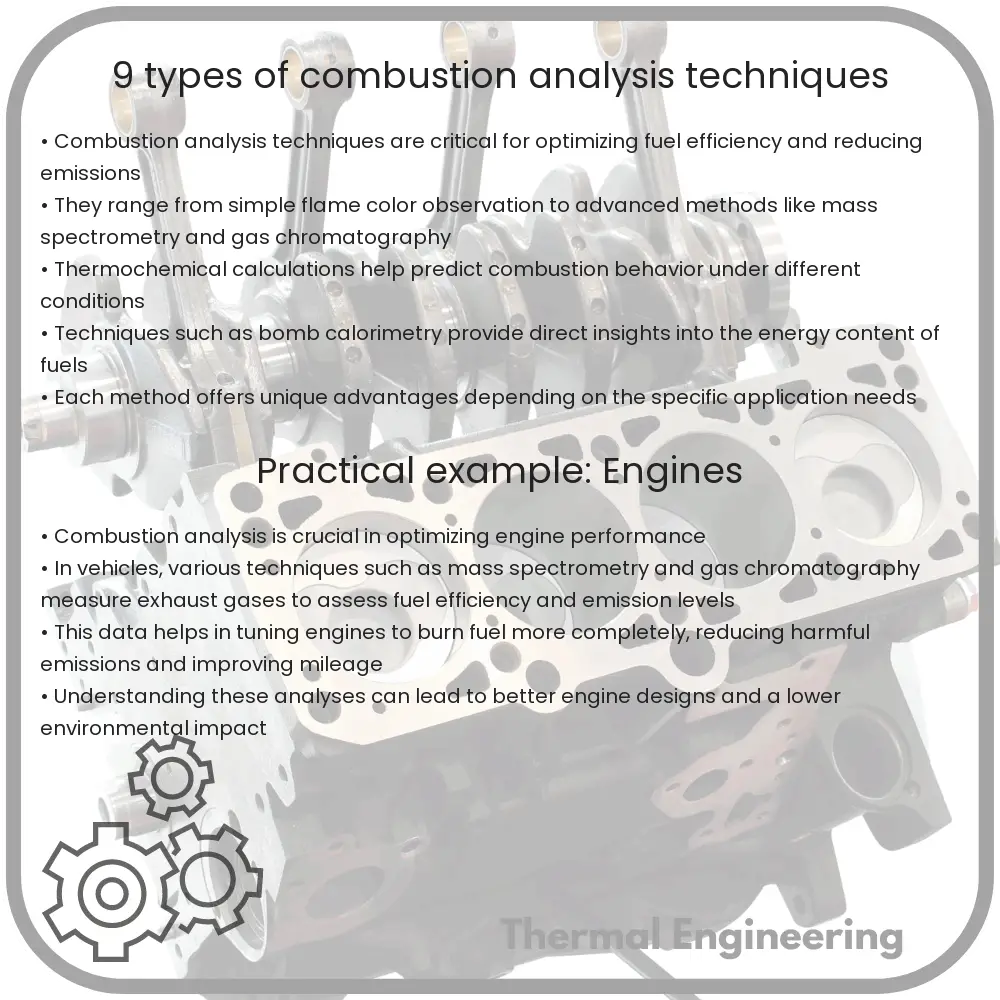Explore 9 essential combustion analysis techniques to optimize fuel efficiency, reduce pollution, and ensure safe equipment operation.

9 Types of Combustion Analysis Techniques
Combustion analysis is crucial for optimizing the efficiency of fuel-burning equipment, reducing pollution, and ensuring safe operation. Different techniques are used to analyze the combustion process, each with its unique applications and advantages. Here, we explore nine common types of combustion analysis techniques used across various industries.
1. Flue Gas Analysis
Flue gas analysis involves measuring the concentration of gases such as CO2, CO, O2, and NOx emitted from combustion equipment. By analyzing these gases, technicians can adjust the air-fuel ratio, improve combustion efficiency, and ensure compliance with environmental regulations.
2. Bomb Calorimetry
Bomb calorimetry is used to measure the heat of combustion of a particular fuel. In this method, a sample of the fuel is burned in a high-pressure container (bomb), and the resulting temperature change in the surrounding water jacket is measured to calculate the energy content of the fuel.
3. Thermogravimetric Analysis (TGA)
TGA measures how the weight of a material changes as it is heated. This technique is helpful in studying combustion kinetics and the thermal stability of materials, providing insights into the stages of fuel decomposition and oxidation.
4. Mass Spectrometry
Mass spectrometry is used to identify chemical species and measure their concentrations in the combustion gas. By analyzing the mass-to-charge ratios of the ions, this technique helps in detailed chemical analysis of the combustion products.
5. Fourier Transform Infrared Spectroscopy (FTIR)
FTIR is a method that identifies gaseous emissions by detecting their molecular vibrations. It provides quantitative and qualitative analysis of the gases produced during combustion, which is vital for monitoring pollutants and improving combustion processes.
6. Chemical Kinetic Modeling
This technique involves using mathematical models to simulate chemical reactions occurring during combustion. By predicting how various factors like temperature and pressure affect reaction rates, engineers can optimize combustion conditions for improved performance and lower emissions.
7. Laser Diagnostics
Laser-based techniques, such as Laser-Induced Fluorescence (LIF) and Particle Image Velocimetry (PIV), are instrumental in visualizing and measuring parameters like temperature, species concentration, and fluid dynamics within combustion chambers.
8. Gas Chromatography
Gas chromatography separates and analyzes compounds that can be vaporized without decomposition. Used primarily for analyzing liquid fuels and the small organic compounds produced in combustion, it assists in understanding the composition of fuel and its combustion products.
9. Oxygen Bomb Calorimetry
Similar to bomb calorimetry, oxygen bomb calorimetry involves burning a sample of fuel in a pure oxygen environment to measure its calorific value. This method offers highly accurate results and is widely used in fuel analysis.
These combustion analysis techniques provide valuable data that helps in the development of more efficient and cleaner combustion systems. Whether for industrial furnaces, vehicle engines, or power plants, understanding the detailed mechanisms of combustion through these methods leads to better fuel utilization and reduced environmental impact.